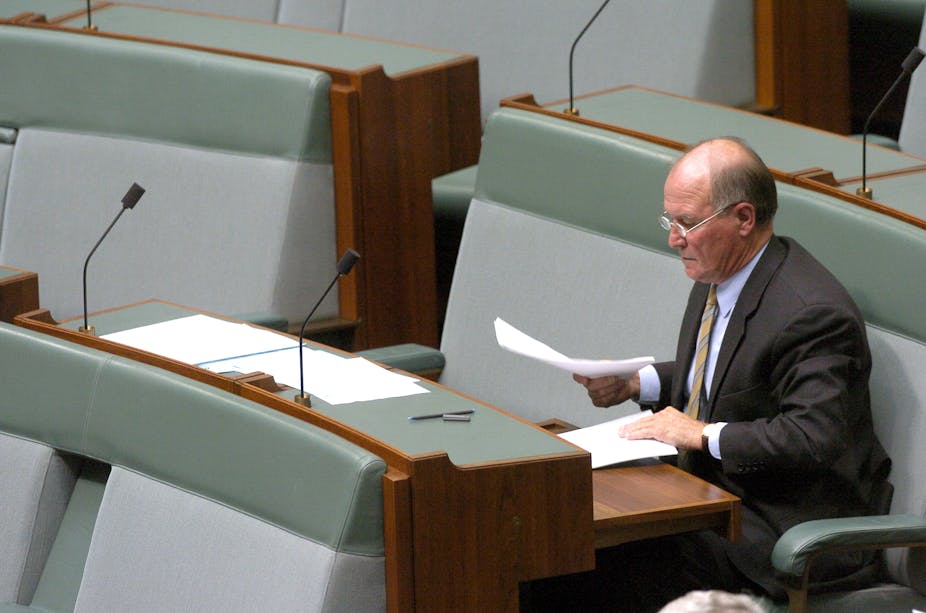Independent MP Tony Windsor has said he won’t back the government’s Mineral Resources Rent Tax unless more is done to make coal seam gas mining sustainable.
He has called for $200-400 million annually from the tax revenue to go toward bio-regional assessments. He also wants to see the Commonwealth have greater power over granting coal seam gas mining rights.
The term “coal seam gas” or CSG is being heard more often, and usually generates emotional responses.
The gas, mostly methane, occurs in coal beds that are within sedimentary rock formations in geological basins. In many cases, these basins also support catchments that have drainage systems with prime agricultural soils and prized alluvial aquifer (sediment deposit) systems.
The gas-bearing coal seams may be shallow or deep. Where they are shallow, these seams are often desirable targets. But in many cases they may also underlie alluvial or other aquifer systems.
Small-scale production of CSG has been around for 10-12 years, but the exponential increase in activities in the past two to three years has caught both governments and the community ill-prepared. In the area of water resources and regulation, most emphasis in the past decade has been on drought-related issues rather than mining.
The relationship between CSG and groundwater is intimate. Within the sedimentary basins there are a variety of aquifers including the highly valuable aquifers of the Great Artesian Basin (GAB).
GAB aquifers occur both above and below some of the coal seams, which vary in thickness. These aquifers are the more permeable sandstone layers, and are bounded above and below by low-permeability layers such as shales and siltstone.
Usually the coal seams themselves hold some water. In certain locations they are used as aquifers, commonly for livestock supply.
The GAB artesian water resources are large scale, unique and exceptionally important; they enabled much of western Queensland and NSW to be developed from the late 1890s.
Within the GAB there are numerous sub-basins. These artesian supplies were significantly over-utilised and poorly managed until the 1960s when water pressures started to drop. Combined federal, state, and private strategies were then implemented to reduce waste and restore pressures.
Geological and water resources are part of dynamic natural systems. Management requires understanding and knowledge of these systems. This requires data, which comes from measurements and monitoring. Groundwater systems are an example of a major challenge, as they are “hidden” and require a different approach to surface waters.
The big question is who does this management, and who takes responsibility for it in the long term? There has always been a degree of uncertainty about whether it is state or federal and who pays. Before the mid-1990s and introduction of a user-pays system there was better interaction between federal, state and private agencies, and communities.
There is no doubt that if CSG and water resources are to be managed in a sustainable manner, this must be based on data collection, organisation and assessment. This has certainly started via the National Water Commission (NWC).
State agencies received “blocks” of funding, but mostly for specific projects. Substantial federal funds went to the Bureau of Meteorology (BOM) to collect water data nationally. But groundwater still remains a major challenge.
So there are several requirements for improving the sustainability of CSG extraction. One is the broader understanding of hydrogeology. This is based on knowing the geology, but considering it from the aspect of bearing water.
The federal government has made Geoscience Australia a focus groundwater agency at a national level. This is an important step in the right direction but state agencies – which are “on the ground” – need more support to compile, integrate and interpret data. This requires additional funding.
Information (such as water levels and salinity) needs to be collected on a regular basis for both groundwater systems (via bores) and surface systems (stream gauging stations). Computer systems these days can handle large data sets, and there is increasing capability for telemetered data, plus remote access.
Data must, however, be in a format that is understandable by the broader community; in formats such as computer-based 3D visualisation, for example. These technologies exist, but are not yet widely implemented at effective scales.
Tony Windsor has suggested allocating substantial funds from tax revenues for “bio-regional” assessments, and setting limits on CSG exploration. In theory both ideas have merit, but the application is not straightforward.
The additional funding is clearly needed. Regional scientific assessments of natural systems are highly desirable, especially when integrating different disciplines.
A major challenge is who would actually do the work: federal, state, local governments, private sector, consultancies, regional environmental organisations, research agencies, a combination of these? All take a different approach, but data and other outcomes would need to be integrated. Local communities should also play a role.
Regional studies also take many years to complete, and would impose unreasonable delays on utilising this valuable resource. The surface component of these studies could be implemented relatively easily. But the subsurface component would require longer timelines.
New data should also be incorporated. We know a lot about how CSG systems operate, but need to consider each location separately and at different scales spatially (such as local, catchment, basin) and temporally (seasonal, years, decades).
CSG operators appear to have learnt much over the last several years, in particular how to interact with landowners and stakeholders. There is more acceptance of the view that local landscapes should be sustainable in the long term. Increasing effort is therefore put into community consultation.
But there is still a long way to go in developing an holistic assessment of the sedimentary basin groundwater systems of Australia in which the CSG occurs, the needs of other users of groundwater, and interaction with many local stakeholders.

